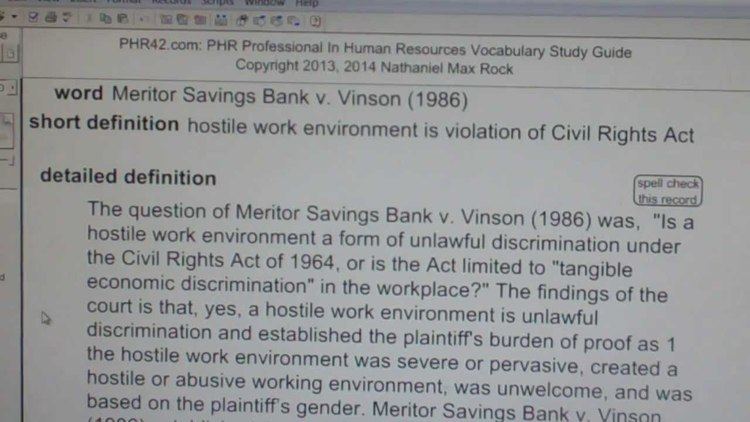Citations 477 U.S. 57 (more) End date 1986 | Concurrence Stevens | |
 | ||
Full case name Meritor Savings Bank, FSB v. Mechelle Vinson, et al. Majority Rehnquist, joined by Burger, White, Powell, Stevens, O'Connor Concurrence Marshall, joined by Brennan, Blackmun, Stevens Ruling court Supreme Court of the United States Similar Harris v. Forklift Systems, Inc., Oncale v. Sundowner Offshore Services, Inc., Burlington Industries, Inc. v. Ellerth | ||
Meritor savings bank v vinson 1986 phr sphr human resources license exam vocabubee com
Meritor Savings Bank v. Vinson, 477 US 57 (1986) is a US labor law case, where the United States Supreme Court recognised sexual harassment as a violation of Civil Rights Act of 1964 Title VII. It established the standards for analyzing whether conduct was unlawful and when an employer would be liable.
Contents
- Meritor savings bank v vinson 1986 phr sphr human resources license exam vocabubee com
- Facts
- Judgment
- Significance
- References
Facts
After being fired from her job at a Meritor Savings Bank, Mechelle Vinson sued Sidney Taylor, the Vice President of the bank. Vinson charged that Taylor had coerced her to have sexual relations with him and made demands for sexual favors while at work. Vinson stated that she had intercourse with Taylor 40 or 50 times. Additionally, she testified that Taylor had touched her in public, exposed himself to her, and forcibly raped her multiple times.
She argued such harassment created a hostile working environment and a form of unlawful discrimination under Title VII of the Civil Rights Act of 1964. Vinson sought injunctive relief along with compensatory and punitive damages against Taylor and the bank.
The primary question presented was: "Is a hostile work environment a form of unlawful discrimination under the Civil Rights Act of 1964, or is the Act limited to "tangible economic discrimination" in the workplace?"
Judgment
The Court held that Title VII was "not limited to 'economic' or 'tangible' discrimination," finding that the intention of Congress was "'to strike at the entire spectrum of disparate treatment of men and women' in employment. . ." The Court pointed out that guidelines issued by the EEOC specified that sexual harassment leading to noneconomic injury was a form of sex discrimination prohibited by Title VII. The Court recognized that plaintiffs could establish violations of the Act "by proving that discrimination based on sex has created a hostile or abusive work environment." Plaintiffs with hostile environment-styled claims must prove that the challenged conduct:
Catharine MacKinnon, author of Towards a Feminist Theory of the State, was co-counsel for the respondent, and wrote the respondent's brief.
Significance
A review of post Meritor reveals that the determination of what constitutes "severe or pervasive conduct" is invariably based on an examination of the totality of circumstances. Moreover, in gauging the totality of circumstances, the lower courts typically focus on some or all of the following four factors:
- the level of offensiveness of the unwelcome acts or words;
- the frequency or pervasiveness of the offensive encounters;
- the total length of time over which the encounters occurred; and
- the context in which the harassing conduct occurred. See e.g., Vance v. Southernbell Tel. & Tel. Co., 863 F.2d 1503 (11th Cir. 1989) (after the trial court granted a defense motion for judgment notwithstanding the verdict on the ground that a noose hung over a black employee's desk on two different occasions was not enough, as a matter of law, to establish that the alleged racial harassment was a persistent, pervasive practice, the appellate court held that the determination of whether the defendant's conduct was sufficiently "severe and pervasive" did not turn solely on the number of incidents alleged by the plaintiff, but was to be based on a consideration of all the circumstances, including the number and severity of individual incidents of harassment.)
